
Typhoon Tip
-
Posts
41,641 -
Joined
-
Last visited
Content Type
Profiles
Blogs
Forums
American Weather
Media Demo
Store
Gallery
Posts posted by Typhoon Tip
-
-
50 minutes ago, kdxken said:
Seeing a lot of talk about a heatwave due to slowing global winds. He's an example
could you please repost this in the July thread ?
-
 1
1
-
-
10 minutes ago, MegaMike said:
Perhaps too bad for some ... I was Meteorologically raised in older tech, such as this,
954 FOUS61 KWNO 271200 OUTPUT FROM NAM 12Z JUN 27 25 TTPTTR1R2R3 VVVLI PSDDFF HHT1T3T5 TTPTTR1R2R3 VVVLI PSDDFF HHT1T3T5 ALB//847837 -0909 241204 67161111 BTV//802752 -0411 251203 64151208 06000687250 00706 231609 68181212 06000626954 02207 221811 66201208 12005929543 10199 221814 70141313 12000638540 00500 191717 69181211 18010919839 12297 191814 70131612 18005807749 02198 161921 70151612 24011967337 -1099 161713 72151812 24003957968 03397 141818 70141912 30000786558 02899 131908 74241813 30012895446 02298 111813 71201811 36001843241 00996 101812 76242011 36000874310 02498 091909 73231811 42009852625 00005 132913 72181614 42003823119 00206 112610 71191312 48000892414 -0210 153009 71151115 48000843920 -1310 142808 69151012 54000663735 -2107 143008 71211215 54000734331 -1007 142907 69181111 60000693923 -0405 143009 72221415 60000724141 -1106 143105 70201213 BOS//776234 -0710 251203 65171208 LGA//867657 00300 240608 70171313 06000676942 00211 241208 67191209 06000656964 -0501 231111 71201314 12000656453 -0312 231512 68181311 12000728441 -0400 221211 72181514 18000608142 -0601 211811 69171412 18002978326 02100 201207 72181713 24004979552 01099 191609 71161712 24003987538 00798 171711 75211914 30005968645 00497 152012 73201813 30000756838 00096 142209 76261915 36000916746 -0397 122213 75232114 36000786343 01095 121809 78272215 42000994619 01496 112312 74222112 42005897374 -9995 112709 77252215 48000832632 -0201 123011 74221815 48000713957 00403 143312 74231915 54000552619 -1704 113008 74241616 54000542143 -1504 143007 74251816 60000574144 -0105 123109 73241515 60000553438 -0701 132805 75271916 PHL//918868 01198 220710 72171714 IPT//986959 00697 221306 72161813 06000858363 -0999 211010 73191714 06004988444 02698 211609 72161613 12000948336 00298 210910 73191814 12007998343 -4798 201614 73181713 18003997718 01899 191207 74191814 18005998434 -1899 181611 73171713 24001986925 -0497 172109 75221914 24002998744 -0597 171810 74171913 30000676231 00294 142308 77292115 30001907857 03196 142007 76231913 36000665234 03293 122111 79302215 36032894735 02596 132803 76242013 42006896659 08293 122909 77262114 42005782248 02302 143408 74211714 48000886466 00497 153308 75241915 48000971740 00309 173408 71151814 54000442742 -1404 142909 75272016 54000752836 00103 163004 73211714 60000492040 01302 143009 75282116 60000655230 00299 152303 74241713
...which I find to be very useful. Over the years, mere sight of these numerical values ...it's like "painting by numbers" - in the mind, you draft very useful prognostic landscapes based upon what they mean and mean over time..etc...
The NAM is what it is in terms of either popularity or verification... but losing above would be a loss -
-
12z NAM has fully committed to positioning the warm front N of NH/MA border, tomorrow by 18z ..But it is in the process of diffusing in that position.
Up near Brian may have a late day high -
Pretty impressive overall correction by the non-Euro cluster in favor of the Euro has taken place over the last 24 hours. I recall mentioning to Scott I was on the fence at this time yesterday. On one hand, climatology and years of scorn and sorrow at the hands of badly handled (models and man) BD air mass damming was too in favor of the GFS to ignore it. On the other hand, the Euro was doing just that...completely ignoring, at like 2.5 days lead - a time in which it is seldom grossly wrong. But ...in it's defense, it was different in the surface high pressure handling - in that it was more progressive in sliding it E out of the area faster. This supplied less inhibition to displacing the warm front N... etc...
Don't mean to speak as though it's already all happened ...but it's pretty clear where this is destined.
-
19 minutes ago, CoastalWx said:
Yep. Easily.
It'll by 88-ish at FIT
Light W to WNW flow and all guidance blend of +16C 850s with sigma level ( typical cloud height) RH's modeled 50% or less is ample sun - under apex max solar no less. Elevated launch temperatures as well because Saturday's been correcting warm and warmer, and that's high confidence at this point. If anything, 2 or 3 clicks above machine numbers is safe. Now...if these modeled metrics change, okay - but as of now..
Folks are judging the day based on the cool feel now - this always happens. Looking at a blizzard in the winter models when it's 55 degrees is a sure bet trigger for a cavalcade of neg-head downer posts about its unlikeliness. But if in that moment the writer is typing it happens be -9 outside, the tenor in here is of course "too cold" and we'll end up too suppressed just the same
-
 1
1
-
-
14 minutes ago, HoarfrostHubb said:
what people want -
I've found over the years of this social media's engagement ( as has everyone probably - ) that people lead with one sentence pot shot posts that they either know are wrong, or are of want so badly that they are molding analysis to conform to those desires. they then sit back and gauge other's responses in some fleeting hope that they'll get a reply that supports their perception as actually being possible.
ha
-
 3
3
-
 2
2
-
-
Fwiw, within margin for error, low grade heat wave in typical warmer climes ... like the CT R valley/ E of the ORH hills, is within reach on the 0Z MEX Mon - Thur
Right now Wednesday falls shy, but I just get the feeling that we add a degree to that outlook ever day and find that it's really dryer DP thing, but still within T reach.
"Low grade" as in 90 or 91, sub-advisory
-
 1
1
-
-
30 minutes ago, CoastalWx said:
I’d like to see more of a trough into the Rockies like this last heat burst. I do think a piece could break off though.
Ridge builds more towards the Rockies and west coast around day 10, but then slowly retros so that it may open up the door to the Gulf of Mexico at the end of the 11-15 day. Note I’m just looking at the EPS.
As is ... sure.
I just would remind folks 10 days to two weeks back the illustration of the runs were torpid at best, and at times absent of the eventual destiny of a bigger ridge anomaly/heat.
However, looping - like watching them in cinema - conveyed a different suggestion. It's a situation where we could see another of these materialize, much in the same way ... coming out of an initial state where aspects are more vague. But, doing so heading into climo, + CC attribution, + the fact that as is, there is a + thickness anomaly due to WV loading ( probably related to former) and lows are going to be elevated. It's entirely possible to put up a top 10 or better July without even observing an official heat wave. ...etc. We're in a vulnerability for higher means...
Maybe "possibly historic" is too strong for some people, fine - call it above normal. whatever
You know ... any time and any place on Earth, since about 2002, whenever there's been mere suggestions hinting at the possibility of above normal temperatures, the return has been pretty dependable.
-
 1
1
-
-
19 minutes ago, CoastalWx said:
4th looks warmer on euro luckily.
Just keep that ensemble trough latitude shallow and we'll be fine.
-
 1
1
-
-
Saturday looks toasty on this NAM run
-
Guys... "possible" is not a slam dunk. Folks should just be prepared for the possibility.
-
5 minutes ago, SnoSki14 said:
Really? I see some ridging out west and a sort of meh pattern for us. Doesn't look extreme in terms of heat especially in comparison to recent stretch
The PNA in the telecon spread collapsed ...
These negative EPOs bursts during a PNA that is neutral negative ends up displacing westerlies S through the Rockies. This is what precisely led to this recent heat. I see vestiges in the behavior of the models as though that tendency is lurking. For example, heights keep rebuilding between HA and California.
-
The operational versions seem to conserve the progressive nature to the mass fields through the 4th weekend ... this actually keeps are chances for fair weather higher if that prevails that way.
-
Or not ... but there are some super synoptic flags that slope in favor of warmer than normal, CC footprint not including.
-
 1
1
-
-
53 minutes ago, HoarfrostHubb said:
Show me
onin thedollbum where CoC temps hurt you…I'm sure he'd be just glad to show you -
-
 1
1
-
-
Saturday could sneakily become a low risk severe day ...
I think I see what's been going on - and the Euro may have been superior in this regard. The flow's more progressive, and the high that is passing N of the region through tomorrow, is faster moving off S of the Maritime in the prior Euro runs than the GFS, which in delaying that departure ...yeah, it's mass fields are holding damming in longer...
This 12z GFS run inched a little N with the warm front again - now between the Pike and Rt 2 at 18z. Two runs ago it was near NYC
But here's the thing, the Euro's front was ironically slower, and the GFS is now faster with the trailing cold front. I don't think the lapse rates are good given this ( but haven't seen soundings...) but when you dawn with warm front escape, then have a cool boundary into western zones later in the day, that's a typical severe set up - in principle. There's also a right exit--> entrance relay as a 500 mb S/W perturbation moves through NNE in the afternoon.
-
 1
1
-
-
2 minutes ago, mreaves said:
Or hiking or playing golf or biking or lawn work or attending an outdoor concert or ballgame etc.
Haha ... in other words, it's only cold if one's layin' around in sloth doin' nothin'
-
 2
2
-
-
12z NAM looking more warm sectory in the grid:
54006967438 01098 152008 72181814 60000985338 01796 121809 74211814
That's a SSW wind at Logan, with 900 mb T to +18C ... 100mb is +21C at 18z, which is probably good for 26 C in the 2-meter. ALB and LGA are both +25C at that level, which is about 30 or 31 in the 2-meter.
We may have some still lingering frontal droop E of the Berk's but that's definitely more Euro suggestive.
Here's the NAM's synoptic representation at 18z
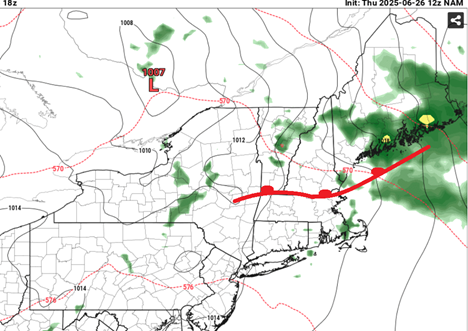
-
 2
2
-
-
Doesn't Kevin live close to that Vernon ... Rockville area of CT ... where it is presently 62/57
priceless -
-
 2
2
-
-
5 minutes ago, CoastalWx said:
I hear ya. I’ve been disgusted with the gfs lately. It was so bad for last weekend into Monday. Even 48 hours out.
Ha...You gotta understand ... I grew up in the 1980s and 1990s modeling arrogance - which means ...I was left heartbroken more than not. That steady abuse of being gaslit by model solutions convincing us of a reality that would only prove fantasy, turned me into an neg nazi when it comes to situations where in one hand, it's what I want, and in the other, it's the looming reality that god is an asshole. There's not a lot of evidence defending the latter, so ...we pick the model solution that best aligns with that principle and we'll always score remarkably well. LOL
-
 1
1
-
-
13 minutes ago, CoastalWx said:
IMO Euro is usually better than the GFS for damming. I'm wondering if it's more synoptics that's an issue. If I'm wrong so be it, but I feel like GFS is too far south.
OH I'm on fence. I'm just trying to objectively lay out the differences. I did look at the 06z GFS and it trended N - that could be an early capitulation. we'll see. The NAM fwiw was Ner than it's previous 00z run...
-
16 minutes ago, CoastalWx said:
Skynet Euro looks like the op too.
I have seen maybe 3 times spanning decades worth of years ...whence the warm solutions won out over BD air mass lay-ins, and they were all in the last 10 years. I don't recall specific dates, but there was one where all the models even the day before, had moderately well defined BD boundary replete with the whole 2-meter large T correction punching SW clear to NYC by mid day. 3pm rolls around it was still 88 in Nashua NH. I was looking at the satellite, and there was no impression that boundary even existed anyway but there was a drape mid way up the Maine shore.
I think with models being much better, I have noticed that the improvement kind of makes them over-sensitive too? - you know, 20 years ago, the models were never aggressive enough with these things. Something like that. I'm wondering if this one of those situations with the GFS just ending up too aggressive.
See ...even a crushingly mundane weather synopsis, there's something to be excruciating about hahaha
-
Euro for 18z Saturday
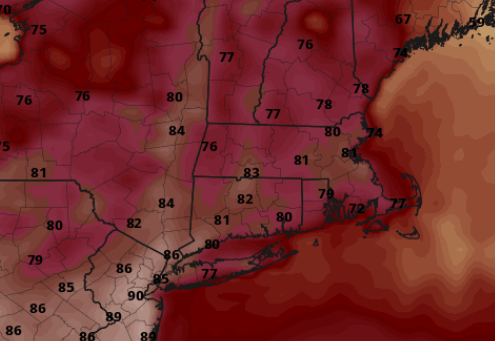
GFS ...
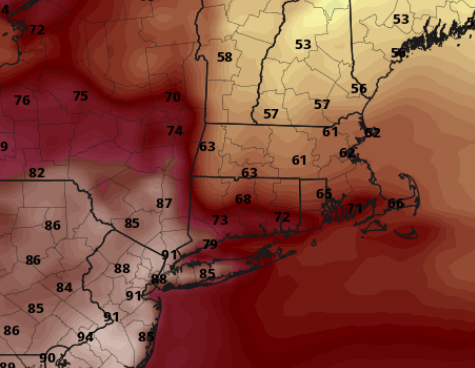
We all know that the GFS is climatologically more sound than the Euro, particularly when considering the 24 to 36 hours prior to this 18z layout above. Today's slab of Canadian polar air getting nice and jammed into the region does not typically displace by merely weak warm front momentum/kinematics - in acknowledgement of both theory and practic, the Euro is out to lunch.
on the flip side ... The Euro is seldom wrong this close. It's an interesting little test here. ..
-
 1
1
-
-
-
1 minute ago, dendrite said:
Nah BOS took the sensor offline. It’s still pulling previous data for the :54 ob I think.
This is BOS though…not some shmuck airport like BML. It shouldn’t take 24hrs running in circles to figure this out.
well, okay - we saw that, but I wasn't sure if it was a sensor malfunction or a ledger thing.



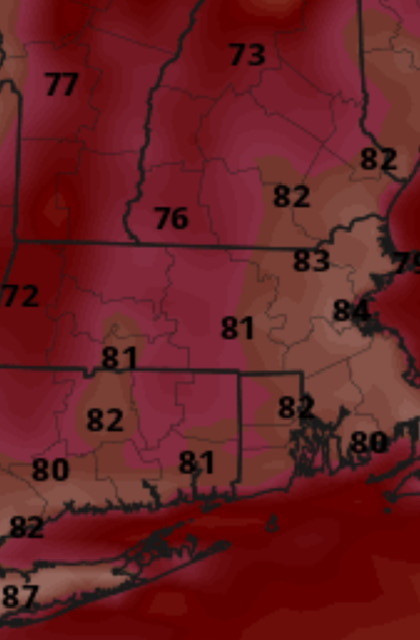
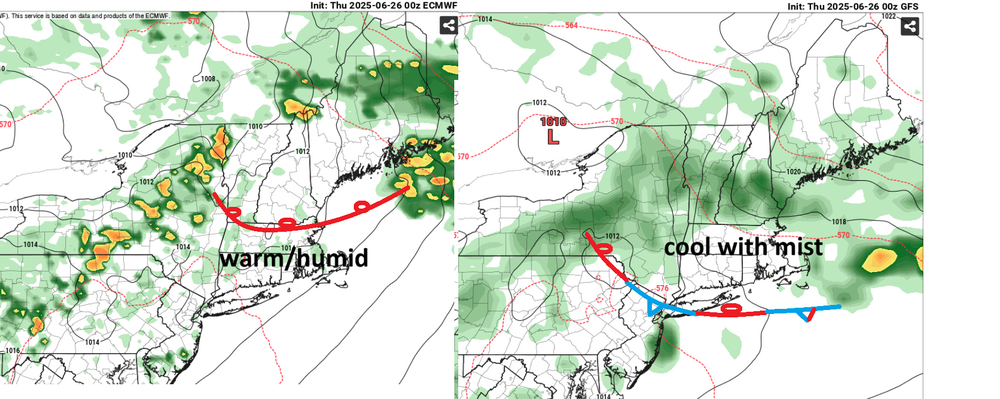

July 2025 Obs/Disco ... possible historic month for heat
in New England
Posted
Hey Scott ... re our recursion argument, get a load of the 12z GGEM
Look familiar ? ... this is emerged out of a banal/flat look, albeit modestly above normal in its own rights, pattern orientation from the previous couple of cycles. This is just for the example for now -